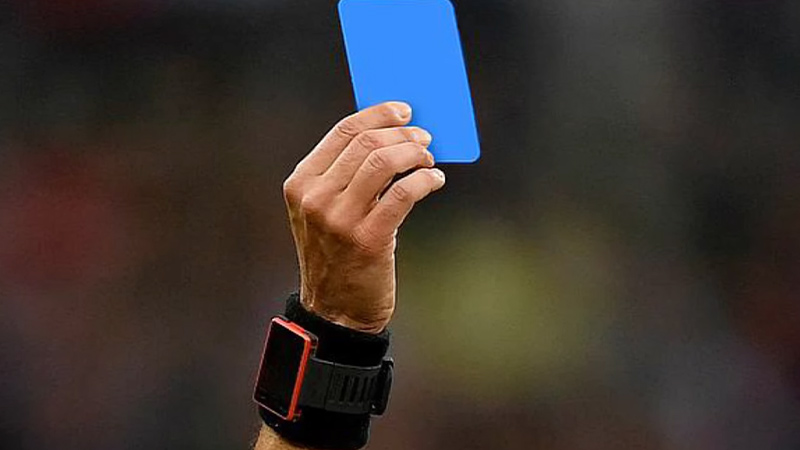

Sports Extra
Blue Card: Football World Divided Over Sin Bin Proposals
The world of football is buzzing with the potential introduction of a new disciplinary measure: the blue card and its accompanying “sin bin”.
This system, currently in the trial phase at lower levels, envisions a 10-minute temporary dismissal for certain offences, aiming to tackle dissent and cynical fouls without resorting to a full red card. However, the proposal has been met with mixed reactions, leaving the future of the blue card uncertain.
What Is This Blue Card? The Right Question To Ask
Imagine a blue card alongside the familiar yellow and red. In essence, if a player commits an offence deemed worthy of punishment but not a full dismissal, they receive a blue card. This sends them to a designated “sin bin” area for 10 minutes, leaving their team temporarily shorthanded. Two blue cards or a combination of blue and yellow would result in a red card and dismissal.
Proponents: A Brighter Yellow?
Advocates for the blue card see it as a more nuanced deterrent compared to the black-and-white approach of yellow and red. They argue that it offers referees an additional tool to manage on-field behaviour, discouraging dissent and tactical fouls without ruining the game’s flow with a full red card. Additionally, it allows for a “cooling-off” period for players, potentially reducing heated confrontations and promoting sportsmanship.
Opponents: A Recipe for Chaos?
Critics, including many Premier League managers, raise concerns about the blue card’s potential impact. They fear it could disrupt the game’s rhythm, creating stop-start encounters and tactical confusion. Additionally, concerns exist regarding unclear regulations and potential inconsistencies in its application by referees. Some also argue that it disrupts the traditional punishment structure, potentially weakening red cards’ impact.
Current Status Of Blue Card Rule: On Hold, But Not Out
While the International Football Association Board (IFAB) initially planned trials, they faced significant pushback, particularly from the Premier League. As of February 2024, the trials have been postponed, but the debate continues.
The Future of the Blue Card
The blue card’s path forward remains uncertain. Further discussions and potential modifications to the system are likely before any wider implementation.
Whether it becomes a game-changer or fizzles out entirely, the blue card proposal has highlighted the ongoing quest to improve football’s disciplinary landscape, ensuring fair play and respect without compromising the sport’s entertainment value.
From Back-Passes to Sin Bins: A Brief History of Football’s Rulebook Revolutions
Football, with its deep-rooted traditions, is rarely one to embrace change readily. Yet, throughout its history, the introduction of new rules has sparked controversy, fueled heated debates, and ultimately shaped the game we know today. Let’s delve into some of the most contentious rule changes that left their mark on the beautiful game:
Back-Pass Blues: In the 1990s, the “back-pass rule” was introduced to combat the tedious tactic of goalkeepers picking up the ball from defenders, effectively stalling play. While it aimed to increase attacking opportunities, it initially met resistance from traditionalists who viewed it as an unnecessary intrusion into the game’s flow. The rule eventually became accepted, leading to a more dynamic and exciting game.
The Offside Revolution: The offside rule, perhaps the most debated law in football, has undergone several revisions throughout history.
The initial “two-man rule” was criticized for its ambiguity and inconsistency, leading to the “three-man rule” in the 1920s. Even then, controversies persisted, with calls for further clarification and technological assistance. The introduction of VAR (Video Assistant Referee) aimed to address these issues, but debates about marginal offside calls and the impact on attacking play continue.
The Three-Point System: In the 1980s, the traditional two-point system for wins and draws was replaced with the current three-point system. This aimed to incentivize attacking play and discourage draws, which were seen as detrimental to fan engagement. While initially met with scepticism, the three-point system is now widely accepted, credited with contributing to a more attacking and entertaining style of play.
The Introduction of Penalties: In the late 19th century, the penalty kick was introduced to punish fouls within the penalty area. However, the rule initially faced opposition from players and fans who considered it an unfair advantage for the attacking team. Over time, the penalty kick became an integral part of the game, although debates about its awarding and execution remain a constant topic of discussion.
The Sin Bin Saga: The recent proposal to introduce a “sin bin” for temporary dismissals similar to other sports like rugby has ignited fresh controversy. Proponents argue it offers a more nuanced punishment than a straight red card, while opponents fear it will disrupt the game’s flow and create confusion. The debate highlights the ongoing struggle between maintaining tradition and adapting to the evolving demands of the modern game.
These are just a few examples of how new rules in football have sparked controversy and ultimately shaped the sport. As the game continues to evolve, future rule changes are sure to ignite further debate, ensuring that the beautiful game remains a constant source of passion, excitement, and, sometimes, heated arguments.



